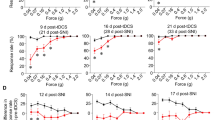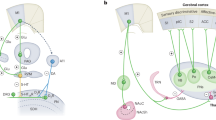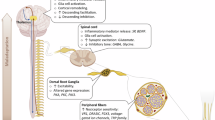Abstract
Introduction
Increased excitability of the motor cortex through transcranial direct current stimulation (tDCS) has been described as a non-pharmacological strategy for the treatment of Spinal Cord Injury neuropathic pain (SCINP). It is also believed that the ability to enhance motor cortex excitability (MCE) could be impaired within chronic SCINP individuals. The following case reports describe the MCE behavior in individuals with chronic SCINP submitted to electrical non-invasive neuromodulation.
Case presentations
This article reports 11 cases with chronic SCINP in which each individual was submitted to a 5-day pre-post MCE analysis in order to evaluate its behavior after the anodal tDCS sessions. All cases maintained ongoing pharmacological treatment. Four individuals have shown negative variation of the MCE, two of which reported pain intensity reduction. Three other individuals had MCE-positive variation along 5 days, from which only one reported a VAS 0.5 pain reduction after the 5th day of observation. The other four individuals did not present significant variation of the MCE.
Discussion
The positive variation of MCE was significantly altered by adjunctive tDCS only in three individuals, though no clinically relevant reduction in pain intensity was reported among these participants. Key factors such as pain and injury duration, age, chronic medication use and underlying maladaptive neuroplasticity may influence responsiveness to brain stimulation within this population. These case reports try to add evidence for cautious recommendation of tDCS in chronic SCINP individuals and to the necessity of identifying groups of individuals that are most susceptible to neuromodulation.
Similar content being viewed by others
Log in or create a free account to read this content
Gain free access to this article, as well as selected content from this journal and more on nature.com
or
Data availability
The datasets generated and/or analyzed during the current study are available from the corresponding author on reasonable request.
References
Ackery A, Tator C, Krassioukov A. A global perspective on spinal cord injury epidemiology. J Neurotrauma. 2004;21:1355–70.
Dijkers M, Bryce T, Zanca J. Prevalence of chronic pain after traumatic spinal cord injury: a systematic review. J Rehabil Res Dev. 2009;46:13–29.
Nicholson BD. Evaluation and treatment of central pain syndromes. Neurology. 2004;62:S30–6.
Finnerup NB. Pain in patients with spinal cord injury. Pain. 2013;154:S71–6.
Dworkin RH, O’Connor AB, Backonja M, Farrar JT, Finnerup NB, Jensen TS, et al. Pharmacologic management of neuropathic pain: Evidence-based recommendations. Pain. 2007;132:237–51.
Pasero C. Pathophysiology of neuropathic pain. Pain Manag Nurs. 2004;5:3–8.
Kumru H, Vidal J, Kofler M, Portell E, Valls-Solé J. Alterations in excitatory and inhibitory brainstem interneuronal circuits after severe spinal cord injury. J Neurotrauma. 2010;27:721–8.
Costigan M, Scholz J, Woolf CJ. Neuropathic pain: a maladaptive response of the nervous system to damage. Annu Rev Neurosci. 2009;32:1–32.
Peyron R, Faillenot I, Mertens P, Laurent B, Garcia-Larrea L. Motor cortex stimulation in neuropathic pain. Correlations between analgesic effect and hemodynamic changes in the brain. A PET study. Neuroimage. 2007;34:310–21.
Parker RS, Lewis GN, Rice DA, Mcnair PJ. Is motor cortical excitability altered in people with chronic pain? A systematic review and meta-analysis. Brain Stimul. 2016;9:488–500.
Nitsche MA, Paulus W. Excitability changes induced in the human motor cortex by weak transcranial direct current stimulation. J Physiol. 2000;527:633–9.
Lefaucheur JP, Drouot X, Ménard-Lefaucheur I, Keravel Y, Nguyen JP, Menard-Lefaucheur I, et al. Motor cortex rTMS restores defective intracortical inhibition in chronic neuropathic pain. Neurology. 2006;67:1568–74.
Ngernyam N, Jensen MP, Arayawichanon P, Auvichayapat N, Tiamkao S, Janjarasjitt S, et al. The effects of transcranial direct current stimulation in patients with neuropathic pain from spinal cord injury. Clin Neurophysiol. 2015;126:382–90.
Fregni F, Boggio PS, Lima MC, Ferreira MJL, Wagner T, Rigonatti SP, et al. A sham-controlled, phase II trial of transcranial direct current stimulation for the treatment of central pain in traumatic spinal cord injury. Pain. 2006;122:197–209.
Nitsche MA, Paulus W. Sustained excitability elevations induced by transcranial DC motor cortex stimulation in humans. Neurology. 2001;57:1899–901.
Kirshblum SC, Burns SP, Biering-Sorensen F, Donovan W, Graves DE, Jha A, et al. International standards for neurological classification of spinal cord injury (Revised 2011) The authors are the members of the International Standards Committee of ASIA. J Spinal Cord Med. 2011;34:535–46.
Bryce TN, Biering-Sørensen F, Finnerup NB, Cardenas DD, Defrin R, Lundeberg T, et al. International spinal cord injury pain classification: Part I. Background and description. Spinal Cord. 2012;50:413–7.
Lefaucheur JP, Drouot X, Menard-Lefaucheur I, Zerah F, Bendib B, Cesaro P, et al. Neurogenic pain relief by repetitive transcranial magnetic cortical stimulation depends on the origin and the site of pain. J Neurol Neurosurg Psychiatry. 2004;75:612–6.
Nitsche MA, Liebetanz D, Antal A, Lang N, Tergau F, Paulus W. Modulation of cortical excitability by weak direct current stimulation—technical, safety and functional aspects. In: Suppl Clin Neurophysiol. 2003;56:255–76.
Mehta S, McIntyre A, Guy S, Teasell RW, Loh E. Effectiveness of transcranial direct current stimulation for the management of neuropathic pain after spinal cord injury: a meta-analysis. Spinal Cord. 2015;53:780–5.
Castillo Saavedra L, Mendonca M, Fregni F. Role of the primary motor cortex in the maintenance and treatment of pain in fibromyalgia. Med Hypotheses. 2014;83:332–6.
Botelho LM, Morales-Quezada L, Rozisky JR, Brietzke AP, Torres ILS, Deitos A, et al. A framework for understanding the relationship between descending pain modulation, motor corticospinal, and neuroplasticity regulation systems in chronic myofascial pain. Front Hum Neurosci. 2016;10:308–20.
Andrade DC, Borges I, Bravo GL, Bolognini N, Fregni F. Therapeutic time window of noninvasive brain stimulation for pain treatment: inhibition of maladaptive plasticity with early intervention. Exp Rev Med Devices. 2013;10:339–52.
Hsieh JC, Belfrage M, Stone-Elander S, Hansson P, Ingvar M. Central representation of chronic ongoing neuropathic pain studied by positron emission tomography. Pain. 1995;63:225–36.
Iadarola MJ, Max MB, Berman KF, Byas-Smith MG, Coghill RC, Gracely RH, et al. Unilateral decrease in thalamic activity observed with positron emission tomography in patients with chronic neuropathic pain. Pain. 1995;63:55–64.
Wrigley PJ, Press SR, Gustin SM, Macefield VG, Gandevia SC, Cousins MJ, et al. Neuropathic pain and primary somatosensory cortex reorganization following spinal cord injury. Pain. 2009;141:52–9.
Gustin SM, Wrigley PJ, Siddall PJ, Henderson LA. Brain anatomy changes associated with persistent neuropathic pain following spinal cord injury. Cereb Cortex. 2010;20:1409–19.
Moisset X, Bouhassira D. Brain imaging of neuropathic pain. Neuroimage. 2007;37:S80–8.
Wrigley PJ, Gustin SM, McIndoe LN, Chakiath RJ, Henderson LA, Siddall PJ. Longstanding neuropathic pain after spinal cord injury is refractory to transcranial direct current stimulation: a randomized controlled trial. Pain. 2013;154:2178–84.
Chagas AP, Monteiro M, Mazer V, Baltar A, Marques D, Carneiro M, et al. Cortical excitability variability: Insights into biological and behavioral characteristics of healthy individuals. J Neurol Sci. 2018;390:172–7.
Fresnoza S, Paulus W, Nitsche MA, Kuo MF. Nonlinear dose-dependent impact of D1 receptor activation on motor cortex plasticity in humans. J Neurosci. 2014;34:2744–53.
Stagg CJ, Best JG, Stephenson MC, O’Shea J, Wylezinska M, Kincses ZT, et al. Polarity-sensitive modulation of cortical neurotransmitters by transcranial stimulation. J Neurosci. 2009;29:5202–6.
McLaren ME, Nissim NR, Woods AJ. The effects of medication use in transcranial direct current stimulation: a brief review. Brain Stimul. 2018;11:52–8.
Ziemann U, Lonnecker S, Steinhoff BJ, Paulus W. Effects of antiepileptic drugs on motor cortex fxcitabilitv in humans: a transcranial magnetk stimulation study. Ann Neurol. 1996;40:367–78.
Rizzo V, Quartarone A, Bagnato S, Battaglia F, Majorana G, Girlanda P. Modification of cortical excitability induced by gabapentin: a study by transcranial magnetic stimulation. Neurol Sci. 2001;22:229–32.
Burns AS, Delparte JJ, Ballantyne EC, Boschen KA. Evaluation of an interdisciplinary program for chronic pain after spinal cord injury. PMR. 2013;5:832–8.
Norrbrink Budh C, Kowalski J, Lundeberg T. A comprehensive pain management programme comprising educational, cognitive and behavioural interventions for neuropathic pain following spinal cord injury. J Rehabil Med. 2006;38:172–80.
Acknowledgements
The authors gratefully acknowledge Mrs. Mariana Vieira da Fonseca Ph.D. for the valuable statistical and methodological consulting, and Dr. Enio Alberto Comerlato and Dr. Denise Lima Medeiros de Melo for gently helping in acquisition of the neurophysiological parameters.
Author information
Authors and Affiliations
Contributions
VGC was responsible for designing the study protocol, writing the protocol, enrolling patients, extracting and analyzing data, interpreting results, updating reference lists, and drafting the final report. RLA was responsible for reviewing the study protocol, interpreting results and reviewing critically the final report for important intellectual content. RBB was responsible for reviewing the protocol, providing feedback on the final report and final approval of the version to be submitted.
Corresponding author
Ethics declarations
Conflict of interest
The authors declare that they have no conflict of interest.
Statement of ethics
The present study was approved by the Associação das Pioneiras Sociais ethics committee (process number 2.357.788). We certify that all applicable institutional and governmental regulations concerning the ethical use of human health data were followed during the course of this research.
Additional information
Publisher’s note Springer Nature remains neutral with regard to jurisdictional claims in published maps and institutional affiliations.
Rights and permissions
About this article
Cite this article
Carvalho, V.G., de Almeida, R.L. & Boechat-Barros, R. Motor cortical excitability behavior in chronic spinal cord injury neuropathic pain individuals submitted to transcranial direct current stimulation—case reports. Spinal Cord Ser Cases 6, 101 (2020). https://doi.org/10.1038/s41394-020-00355-5
Received:
Revised:
Accepted:
Published:
DOI: https://doi.org/10.1038/s41394-020-00355-5
This article is cited by
-
Advances in targeting central sensitization and brain plasticity in chronic pain
The Egyptian Journal of Neurology, Psychiatry and Neurosurgery (2022)



